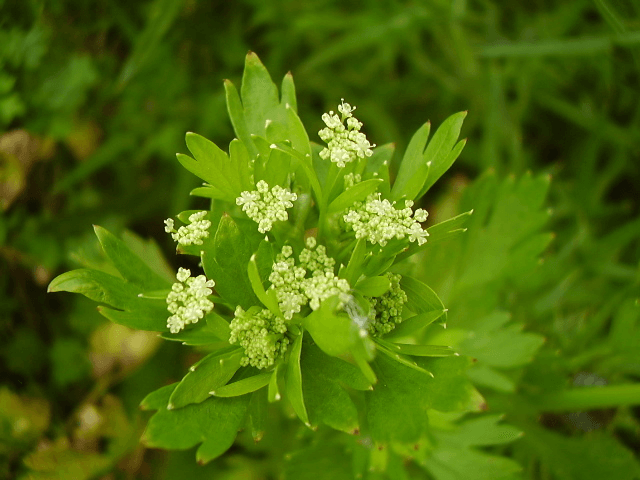- +033 2572 7171
- info@dhanvantary.com

4.5 Rating | 4500 Review

4.5 Rating | 4500 Review
Ajamoda is a very important plant with great ayurvedic medicinal properties. Scientifically ajamoda is known as Apium graveolens. Apium graveolens comes under the family of Apiaceae. The genus is derived from latin, means bee because bees are attracted towards its off white flowers. The species graveolens means heavily perfumed. It is cultivated as a cold crop in India.

It is believed that in ancient Greece, people crown the heads of the athletes with the leaves of ajamonda to honor them. In the 17 th century, it got hybridized to make its bitter taste less prominent.
Ajamoda is known to treat ailments of urinary, digestive, cardiovascular and respiratory. These help to cure high blood pressure, low appetite, digestive weakness, and inflammation, bacterial and microbial infections.
This plant contains phytochemicals which have main responsibility to cure and treat diseases. This plant has carbohydrates, alkaloids, glycosides flavonoids steroids. The plant has phenols and furocoumarins, two main active components. The phenols include apigenin, tannins, apiin, isoquercitrin, graveobioside A and B and phytic acid. The furocoumarins contains osthenol, isopimpinellin, celerin, bergapten, isoimperatorin, celereosideand 5 and 8-hydroxy methoxypsoralen, apiumoside, apiumetin and apigravrin. The seeds and leaves oil of the plant refer to have fatty acids, volatile oils and sesquiterpene alcohols.
On the other hand, plant derived components include camphene, cymene, sedanenolide, palmitoleic, palmitic, oleic, myristoleic, stearic acid, limonene, β-pinene, α-thuyene, p-cymene, γ-terpinene, limonene, santalol, β-eudesmol myristicic, myristic, linoleic, terpinolene, α-eudesmol, 3-n-butyl phthalideand phthalide and α-pinene. The tuber of the plant also have phytochemicals like 5-methoxypsoralen, methoxsalen and the allergen profiling.
Its seeds have very great importance as it contains two to three % of essential oil. It is known to contain glycosides, frocoumarin, selinene, limonene and frocoumarin.
Kingdom
Plantae
Subkingdom
Tracheobionta
Superdivision
Spermatophyta
Division
Magnoliophyta
Class
Magnoliopsida
Subclass
Rosidae
Order
Apiales
Family
Apiaceae
Genus
Apium
Species
Graveolens
This plant belongs to the lowlands of Italy. It is first cultivated as a food in 1623 in France. From the streets of the Italy, its cultivation spreads out in Sweden, Egypt, Ethopia, Algeria and Asia to India. In India, it is grown in Punjab, Haryana, Utter Pradesh and Western Himalayas. Punjab produces around 90% of the ajamoda in India.
| Hindi / Sanskrit | English | ||
|---|---|---|---|
|
Rasa |
Katu, Tikta |
Taste |
Pungent, Bitter |
|
Guna |
Laghu, Rooksha |
Physical Property |
Light, Dry |
|
Virya |
Ushna |
Potency |
Hot |
|
Vipaka |
Katu |
Metabolic Property (After Digestion) |
Pungent |
It balances kapha and vata.
|
Charak Samhita |
Vagbhata |
Sushrut Samhita |
|
Pippalyadi group of herbs |
Pippalyadi group of herbs |
This plant has antispasmodic diuretic anthelmintic aphrodisiac, emmenagogue, laxative, sedative toxic carminative and stimulant properties.
It possess anti-inflammatory properties that reduces the swelling and pain of the joints.
It shows Antifungal activity against Shigella dysenteries, Salmonella typhi, Staphylococcus aureus Staphylococcus album, Maintains blood pressure and cholesterol in normal state.
Roots are diuretic in nature, helps in hypertension and urinary disorders.
It is very helpful in case of hysteria as enhances restfulness and sleep.
This plant is used in treating rheumatism and kidney problems.
Celery seeds are famous to treat diseases like bronchitis, asthma, liver, and spleen diseases.
The roots and the ripe seeds are known for galactogogue, diuretic, nervine stimulant and emmenagogue properties.
It promotes menstruation.
These have anti-cancer properties due to anti-cancer chemicals like polyacetylens and phthalide. These can detoxify carcinogens present in cigarette.
It helps to prevent swelling in the body.
Ajamoda Seeds, Fruits
Two to four grams
Avoid extra use in the case of pregnancy. It can cause uterine contractions.
